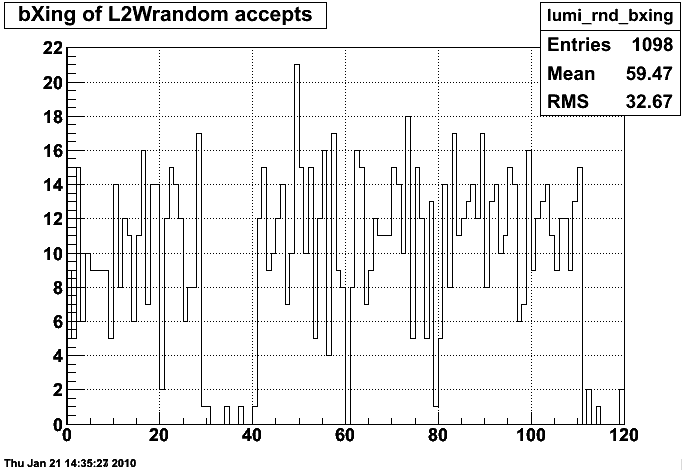- rcorliss's home page
- Posts
- 2013
- January (1)
- 2012
- 2011
- 2010
- December (1)
- October (2)
- September (2)
- August (2)
- June (2)
- May (3)
- April (3)
- March (5)
- February (2)
- January (8)
- 2009
- December (5)
- November (1)
- October (7)
- September (10)
- August (4)
- July (3)
- May (1)
- February (1)
- January (1)
- 2008
- 2007
- My blog
- Post new blog entry
- All blogs
Correcting for kicked bunches in SBB calculation
A problem that has been showing up in the luminosity tables recently is that the ratio of single beam background (SBB) events to total BHT3 events is surprisingly high, in some cases ~50%. To investigate this, I plotted the number of BHT3 (that is, L2W random accept) events as a function of bunch crossing:

Figure 1. Histogram of 7-bit bunch crossings of BHT3 events in run 10093131. The two abort gaps are clearly visible, ending at 40 and 120.
The current prescription is to integrate from bin 80-nY to 39, inclusive, to count the first gap, and from nB to 119, inclusive, for the second. If we follow this here (bY=107 and nB=109 according to cdev), we find we're actually integrating starting two bins before the abort gaps seem to actually start. These first bins have much higher statistics than the rest, and push the background estimate up dramatically. The problem is that the blue and yellow beams aren't continuously filled from 0 to nB(nY). Kicked bunches elsewhere mean that bunch nB+1 may still be filled.

Figure 2. The WCM measurement for blue (blue) and yellow (red) beams as a function of their internal bunch numbers. the blue number corresponds to bXing*3 as defined at STAR, the yellow number is ((bxing+80)%120)*3. We see that there are a kicked bunches (at ~240) that are not contiguous with the abort gaps.
To correct for this, instead of using [80-nY,39] and [nB,119] to define abort gaps that vary by run, we can take the minimal set: [32,39] and [112,119]. The advantage of this is that we should now be well clear of the starting edge of the abort gap. The widths are now constant, which simplifies the math elsewhere. The downside is that the abort gaps will be slightly more statistics-starved.
An additional concern is that given the potentially random nature of the kicked bunches, it's possible that one of the blue bunches that falls in the yellow abort gap will itself be aborted. This will reduce our background estimate by 1/8 for each missing bunch. We could conceivably always check the cdev plots, but there's no easy way to synch this information with the code that calculates the counts in the abort gap.
- rcorliss's blog
- Login or register to post comments
